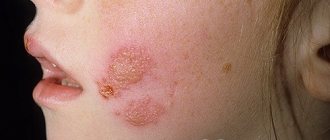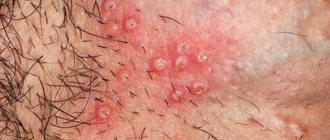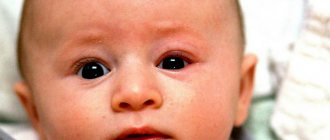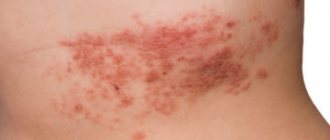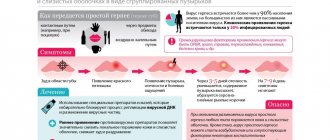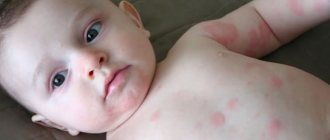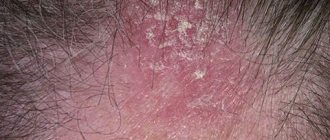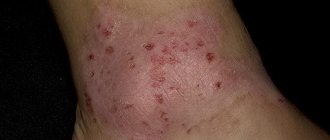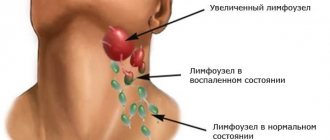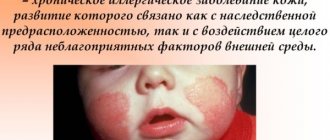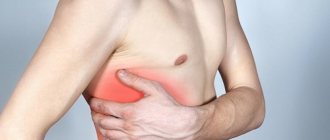Shingles (herpes) is a common disease. It is of viral origin. Localized on the skin of the lower back of the body. But it can infect the face and limbs, and is found on the genitals.
Affects the central nervous system. The causative agent is the varicella-zoster virus, which causes chickenpox. Infects children and adults.
Herpes zoster - what is it?
Herpes zoster is an acute disease caused by the third type of herpesvirus (varicella zoster) and occurs with the development of herpes rashes along the inflamed nerve fibers, as well as with the development of neurological symptoms.
For reference. The disease occurs against the background of reactivation of type 3 herpesvirus (varicella zoster) that persists in the body.
Herpes zoster almost always occurs in people who have had chickenpox. In isolated cases, this disease may develop during primary infections with type 3 herpesvirus in children with severe immunosuppression (children not receiving antiretroviral therapy).
According to the ICD10 classification, herpes zoster is designated as B02.
How to prevent lichen in children?
To prevent infection from passing on to healthy children from a sick child, you should:
- completely isolate the infected child from healthy children;
- avoid contact of the child with stray animals;
- Have your pets examined regularly by a veterinarian;
- instill in children personal hygiene skills.
To prevent the spread of infection to healthy children from a sick child, it is necessary to instill personal hygiene skills in children.
It is important to maintain the child’s immune system at the proper level, give vitamins, strengthen the child’s body, and ensure that the child does not become hypothermic.
Herpes zoster - causes
The causative agent of infectious processes is herpesvirus type 3. When the herpes virus first enters the body, it causes chickenpox. Subsequently, after an acute infection, viral particles remain in nerve cells for life.
Relapses of varicella zoster are manifested by the development of herpes zoster and occur against the background of immunosuppression.
For reference. Recurrent forms of the infectious process are most often observed in HIV-infected people or in patients with malignant diseases. It should be noted that in this case, the rash often appears in the area above the tumor.
In this regard, repeated cases of infection are always considered a reason for a thorough in-depth examination of the patient.
Provoking factors contributing to the development of herpes zoster can be:
- decreased immunity due to hypothermia or heat stroke;
- various immunodeficiency conditions;
- abuse of alcoholic beverages;
- smoking;
- vitamin deficiencies;
- malnutrition, exhaustion, underweight;
- excessive physical activity;
- stress;
- severe fatigue.
How does the virus enter a child's body?
The pathogen Varicella-Zoster enters the child's body when talking, coughing or sneezing. It penetrates the mucous membrane of the respiratory tract, where it begins to multiply. The virus penetrates the skin epithelium through the bloodstream. As a result, the child develops a rash all over his body, which characterizes chickenpox.
Children usually get chickenpox in elementary school. After recovery, they develop strong immunity. However, the virus goes into hibernation mode. It is located in the intercostal nerve ganglia.
The herpes zoster virus in children is activated when favorable factors arise for its reproduction. However, the second time the disease develops differently. The secondary form is called herpes zoster. Children become ill with it only when their immunity is significantly reduced. Sometimes the disease is characterized by a protracted course and is difficult to treat.
Forms of herpes zoster
The disease can occur typically and atypically.
Atypical forms of herpes zoster are divided into:
- abortive (erased);
- bullous (the appearance of large bullae filled with turbid contents is noted);
- hemorrhagic (vesicles filled with bloody contents);
- gangrenous (the development of necrotic foci in the affected area is noted);
- generalized (rashes spread beyond the area of the affected nerve).
Bullous, hemorrhagic, gangrenous and generalized forms are severe and are typical for patients with immunosuppression.
Is shingles contagious to others?
For reference. The infectious agent is contagious. However, patients with chickenpox pose the main epidemic danger to others.
This is due to the fact that herpes zoster and chickenpox are provoked by the same virus, but with chickenpox, the patient’s saliva contains a huge number of viral particles, which are released into the OS (environment) when coughing and sneezing.
Because the varicella-zoster virus can travel long distances in the air, patients with chickenpox are highly contagious.
And the chance of contracting varicella zoster from a patient with herpes zoster is less than ten percent.
It is also necessary to take into account that patients with herpes zoster pose an epidemic danger only for patients who have not previously had chickenpox and people with immunodeficiencies (repeated contact with the pathogen can provoke a relapse of the infection).
Patients with chickenpox are contagious from the last day of the incubation period until five days after the last blistering rash appears.
What medications are used to treat herpes zoster?
Antiherpetic drugs
- Acyclovir - 0.015-0.03 g/kg is divided into 3 single doses and administered in 150 ml of isotonic sodium chloride solution;
- Valaciclovir - 1000 mg every 12 hours with a creatinine Cl of 30-49 ml/min or once a day with a creatinine Cl of 10-29 ml/min and 500 mg once a day with a creatinine Cl of less than 10 ml/min;
- Famciclovir - 500 mg every 8 hours for 7 days
Painkillers - used as needed
- Amitriptyline,
- Gabapentin,
- Capsaicin ointment,
- Lidocaine.
How is herpes zoster transmitted?
The infectious agent can be transmitted:
- aerosol (typical of chickenpox, when the virus is released into the environment with saliva and nasopharyngeal mucus);
- contact (the virus is contained in herpes blisters for the first three to four days of illness);
- through household means (infection through personal hygiene items, bed linen is rare, since the virus is extremely unstable in the environment);
- vertically (infection of the fetus with herpes viruses can occur during pregnancy (transplacentally) or during its passage through the mother’s birth canal).
Prevention
There is no specific prevention of herpes virus disease. It can only consist of maintaining the natural human immune system and increasing the body's resistance.
This is facilitated by maintaining a healthy lifestyle, giving up bad habits, an active physical regime, following the rules of a healthy diet, adequate sleep, hardening, walks in the fresh air, avoiding the aggressive influence of ultraviolet rays, and a harmonious psycho-emotional state of a person.
Herpes zoster - pathogenesis
The disease occurs in people who have previously had chickenpox. The development of herpes zoster is associated with the reactivation of the virus, which, after the initial infection, remains in the nerve tissues for life.
For reference. It should also be noted that some people who have had chickenpox may never get shingles (due to a high level of immune tension).
That is, having chickenpox is not a guarantee of developing herpes zoster in the future.
The mechanisms of reactivation of the herpes virus type 3 are poorly understood, however, the main reasons provoking the development of infection are considered to be a decrease in immunity and old age.
Re-activation of viral particles occurs against the background of partial loss of antibodies specific to the infectious agent against the background of a general decrease in immunity (immunosuppression).
Against the background of activation of type 3 herpes viruses, the development of ganglioneuritis is observed, affecting the cells of the nerve ganglia.
Also, in severe cases of the infectious process, inflammation of the brain tissue may occur (both the brain and spinal cord are affected), as well as damage to internal organs.
The spread of viral particles through the tissues of the nerve trunks is accompanied by the penetration of the pathogen into the skin cells. Damage to epidermal tissues is manifested by the development of inflammatory and degenerative processes in the skin (herpetic rash in the area of innervation of the affected nerve fibers).
In severe cases, hematogenous spread of the pathogen is observed, leading to generalization of the infection and the development of herpetic lesions of internal organs.
The main symptoms of the spread of the virus through nerve tissues are:
- radicular pain;
- rash in the area of the affected dermatome (area innervated by the affected nerve).
For reference. The blistering elements of the rash with herpes zoster are completely identical to the rash with chickenpox.
Herpes zoster - symptoms
Herpes zoster (shingles) occurs in four stages:
- prodromal (symptoms of infection at this stage may manifest themselves in the form of preherpetic neuralgia);
- period of herpes rash (the main manifestations of infection at this stage are herpes rashes);
- convalescence (stage of herpes zoster, after the disappearance of all elements of the rash);
- residual manifestations of the infectious process.
In adult patients, the earliest manifestation of infection is radicular pain.
Pain with herpes zoster is paroxysmal, the intensity of pain symptoms depends on the severity of the patient’s condition. With extensive rashes, the pain associated with herpes zoster is intense, burning, and patients often describe the pain as unbearable.
In children, the pain symptom is less intense and is recorded much less frequently than in adults.
In addition to pain in the area of nerve damage, increased sensitivity of the skin is often noted.
For reference. During periods of prodromal manifestations, symptoms of herpes zoster in humans are manifested by severe weakness, lethargy, drowsiness, irritability, general malaise, febrile symptoms (fever, chills, myalgia and arthralgia, etc.), headaches.
In the area of tissue innervation by the affected nerve (the area of the affected dermatome), a feeling of numbness, a sensation of constant or periodic burning, tingling, and possible moderate pain are noted.
The duration of herpes zoster symptoms during prodromal periods can vary from one to seven days.
During the period of specific manifestations, the main manifestation of the disease is herpes rashes. Severe intoxication and neurological manifestations are also noted.
For reference. Before the rash appears, swelling and hyperemia (redness of the skin) often appear in the affected area.
Elements of the rash with herpes zoster are vesicular in nature. Vesicles (bubbles) are arranged in groups and resemble “bunches of grapes”. Herpes blisters are filled with a clear serous fluid; the vesicle cover is easily damaged by external influence.
When the blisters are injured, after their rupture, weeping erosions and ulcers remain. When the bubbles dry naturally, crusts form.
Nonspecific symptoms of herpes zoster
In addition to the appearance of rashes, patients with herpes zoster (shingles) are concerned about symptoms such as:
- fever (depending on the severity of the patient’s condition, the temperature can rise to 38-40 degrees);
- chills;
- weakness;
- lethargy and irritability;
- pain in the rash area;
- severe swelling (especially with the development of herpes zoster on the face);
- severe headaches;
- sign of acute respiratory disease (acute respiratory disease);
- intoxication symptoms.
When bacterial infections accumulate, the contents of the blisters may fester. Normally, the blisters for herpes zoster are small (about 2-3 millimeters in diameter), however, in patients with various immunodeficiencies, the rashes can be bullous in nature (large blisters, more than a centimeter in diameter).
Also, in weakened and immunosuppressed patients, forms of the disease of a necrotic and hemorrhagic nature may be observed.
For reference. The blisters may take two to four weeks to dry and heal.
The general condition of the patients improves as the blisters dry out.
It should be noted that the rashes with this infection are strictly segmental and unilateral. All elements of the rash are located in the area innervated by the nerve affected by herpes zoster. In severe cases, the rash may extend somewhat beyond the innervated area.
Generalization of the rash, as a rule, is observed on the second to seventh day of illness and is accompanied by a significant deterioration in the patient’s well-being.
For reference. Most often, patients experience damage to areas innervated by the trigeminal nerve or intercostal nerves. Fibers of other nerve segments are less commonly affected.
In patients with severe forms of the infectious process, general cerebral and meningeal symptoms may occur against the background of fever (severe weakness, intense headaches, nausea and vomiting that do not bring relief, stiff neck, photophobia).
Rare manifestations of the disease in adults
For reference. In some cases, the symptoms of herpes zoster may manifest only in the form of radicular pain syndrome. The rash may be completely absent or appear in a single amount.
In such cases, the patient is diagnosed based on the results of laboratory diagnostics for herpes zoster (an increase in antibody titers to the pathogen).
When the facial nerve is damaged, the development of ophthalmoherpes (herpes lesions of the conjunctiva, cornea) is often noted.
Herpetic keratitis is severe and often leads to partial or complete loss of vision.
Ophthalmoherpes is manifested by severe pain and pain in the eyes, dryness of the conjunctival mucosa, the appearance of herpes rashes on the eyelids and conjunctiva, ulcers of the cornea and conjunctiva, photophobia, and decreased visual acuity.
The connection of the tank is also often noted. infection, manifested by purulent discharge from the affected eye.
Specific symptoms of herpes zoster in adults
In the diagnosis of the disease, an important role is played by identifying specific signs of inflammation of the central nervous system tissues.
A distinctive feature of the disease is the appearance of sensory changes in the affected areas, manifested by:
- radicular pain symptoms;
- disorders of skin and temperature sensitivity;
- local pain syndrome in the area of innervation of damaged nerve fibers;
- damage to the fibers of the oculomotor nerves;
- paresis of the upper limbs;
- facial nerve paresis;
- increased pain at night.
Specific neurological symptoms usually develop by the sixth day of illness.
Also, in severe cases, the development of serous meningitis (headaches, vomiting, meningeal signs, photophobia) and encephalitis is possible.
Such complications occur mainly from the second to the eighth day of the rash period.
For reference. When signs of encephalitis appear, a CT scan is required to identify foci of destruction (destruction) of brain tissue.
Treatment
Treatment of shingles in a child can only be done under the supervision of a doctor. He prescribes medications, explains the harms and benefits of using folk remedies.
Drug therapy
Drug therapy for lichen in children can suppress the activity of the pathogen. Antiviral drugs are used for this purpose:
- "Metisazon."
- "Interferon".
- Agents containing interferon.
At the same time, analgesics are used to reduce pain.
“Proserin” stimulates tissue respiration and improves redox processes in nerve cells. It is given to the child 2-3 times a day, 0.001-0.005 g, for 10-12 days. The child is prescribed vitamins C, B, P.
To strengthen the body's natural defenses, the child is prescribed immunostimulants. "Glantamine" improves blood supply to affected tissues and eliminates pain. For external use, Acyclovir ointment is prescribed.
When lichen is complicated by a secondary bacterial infection, the child is given broad-spectrum antibiotics. Features of its treatment in children are related to the age of the patient.
Physiotherapy
Since nerve fibers are damaged when children get herpes zoster, their sensitivity must be restored using electrical stimulation:
- diadynamic therapy;
- electrophoresis;
- UHF – ultra high frequency therapy.
Surface damage is eliminated using ultraviolet light. It is not possible to completely get rid of the lichen virus because it penetrates deep into the nerve endings.
The more microorganisms are on the nerve endings, the more pain the child experiences. Therefore, they are trying to reduce their number as much as possible by using electrophoresis with drugs. Under the influence of electric current, the substance quickly penetrates into the deep layers of the skin and affects the virus. The areas where lichen appears are cleaned daily with antiseptics and wound healing agents.
Physiotherapy is used as an additional method of treating shingles. It is used more often and more widely than in the treatment of adults.
ethnoscience
If a child gets shingles, it is important to follow all the doctor’s instructions. Self-medication is not allowed. Before using folk remedies, you should get permission from your pediatrician. Common ways to combat lichen include:
- Infusion of willow bark. The tree bark is finely chopped and poured with boiling water. The broth is infused for 2 hours. For every 0.5 liters of water take 2 tbsp. l. crushed bark. The product is taken 100 ml before meals.
- Garlic tincture with castor oil. To prepare, take 100 g of garlic and a glass of castor oil, then put the solution in the oven for 3 hours at 60 degrees. Cool the mass and lubricate the affected surfaces 2-3 times a day.
- A paste of fresh cinquefoil leaves is applied to the area with rashes in the form of a compress.
Using such traditional medicine, you can alleviate the patient’s condition.
Complications
A specific feature of the infectious process is the development of postherpetic neuralgia two to three weeks after the acute stage of the disease.
Postherpetic forms of neuralgia are manifested by paroxysmal pain, intensifying at night.
The pain is often severe, burning, unbearable.
For reference. After the attack, the severity of pain subsides. Postherpetic neuralgia can last about one to two months, while the intensity of painful attacks gradually decreases.
Chronic forms of postherpetic neuralgia are typical for patients with various immunodeficiencies.
Diagnosis of the disease
In most cases, diagnosis is not difficult. The diagnosis is made based on specific symptoms.
Confirmation of diagnoses through laboratory diagnostics, in most cases, is required only in the absence of rashes.
For reference. To clarify diagnoses, microscopic examination methods, immunofluorescence analysis, and serological diagnostics are used. PCR diagnostics are also often used.
Differential diagnostic measures are carried out with erysipelas, skin lesions in acquired immunodeficiency syndromes and diabetes mellitus (diabetes mellitus) in the stage of decompensation, zosteriform forms of herpes simplex.
Treatment of herpes zoster on the body
Treatment of herpes zoster should be carried out by an infectious disease specialist or immunologist.
Attention. There is no quick treatment for herpes zoster that allows you to get rid of rashes and radicular pain in a few days.
Treatment of the disease in adults is most often carried out at home. However, patients with severe forms of infection, complications, concomitant pathologies, damage to the 1st branch of the trigeminal nerve and children should be treated in a hospital.
For the treatment of herpes zoster, antiherpetic therapy with drugs containing acyclovir, penciclovir, and valacyclovir is prescribed.
Treatment regimens are prescribed by the doctor.
Additionally, antiplatelet drugs, diuretics, and immunomodulators are prescribed.
To eliminate pain and febrile symptoms, non-steroidal anti-inflammatory therapy is used.
All elements of the rash are treated with chlorhexidine, brilliant green, and Tsindol.
At the stage of neuralgia, group B drugs are prescribed.
